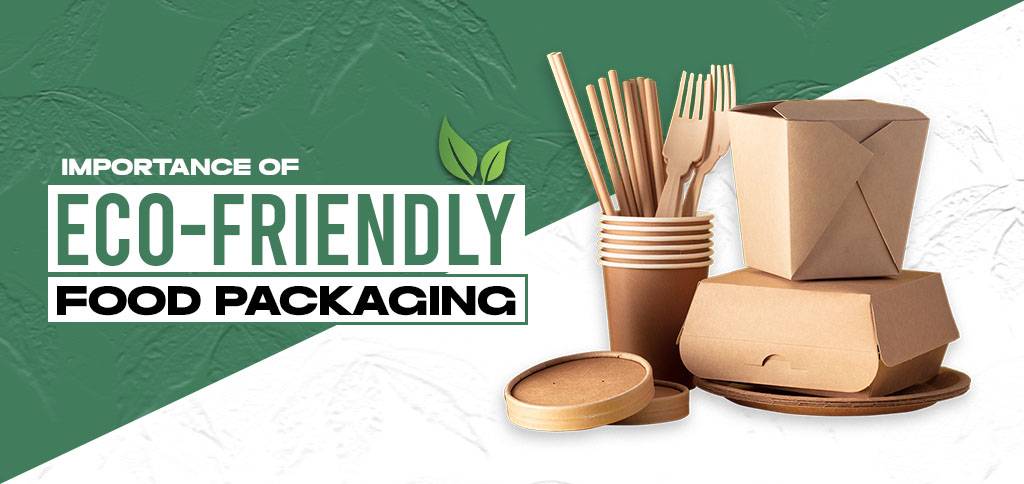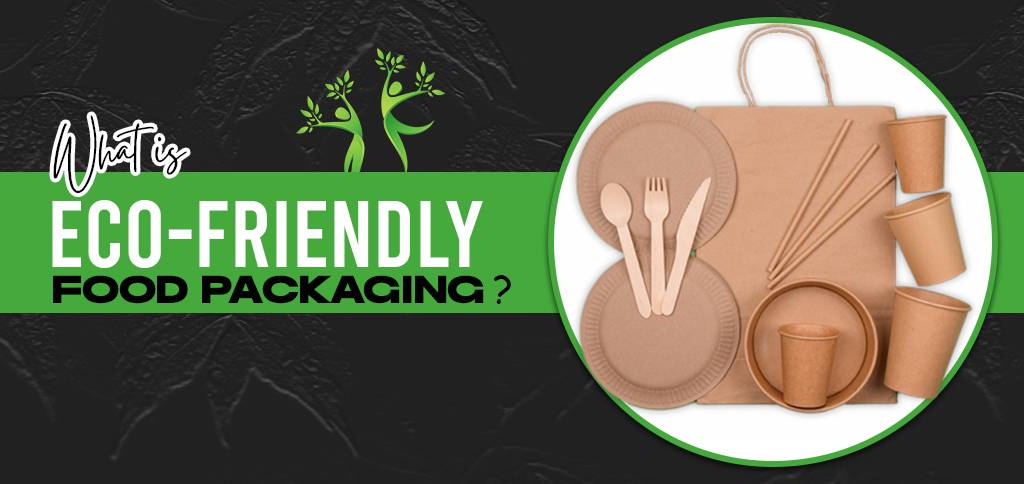
Food packaging is everywhere and is vitally important when keeping your food fresh, marketing your company, and during transportation. But with the planet in desperate need of our help, eco-friendly food packaging is more important than ever.
1. Polyethylene terephthalate: Commonly used to make drink bottles. The most common and most widely recycled of all plastic resins.
2. Low-density polyethylene: Used to manufacture plastic bags and flexible plastic films. This type of plastic is not widely recycled.
The demand for businesses to pursue eco-friendly packaging grows year on year. With 88% of the sea surface polluted by plastic waste and more than 1 million plastic bags filling trash cans each minute, a drastic change is critical. Between 8 to 14 million tons enter our ocean every year. The world produces over 381 million tons of plastic, and 50% is single-use plastic. Eco-friendly packaging aims to reduce waste and help preserve our planet.
What is Eco Friendly Food Packaging?

Eco-friendly packaging that poses no harm to the individuals or their environment throughout its life cycle. It is entirely made of recycled and renewable material, meets the market performance and cost criteria, and once deteriorated, can be recycled into new products. Sustainable food packaging can keep food items safe, fresh, and in top-class condition during the delivery process.
Glass is infinitely recyclable, paper is both recyclable and biodegradable, un-laminated cardboard decomposes fast, and cornstarch does not persist in the environment. Some examples of eco-friendly food packaging include:
Glass Container
Glass is ubiquitous and utilized for a wide range of purposes. It can be recycled and reusable. Therefore, glass can be an alternative to plastic
Cardboard
Cardboard is fully recyclable and 80% biodegradable. Its strength and durability make it an easy choice for many food and cosmetic
Bamboo
Bamboo is another biodegradable eco-friendly that is strong and resistant to high temperatures. This material can be in food packaging lid
Kraft Paper
Kraft paper is one of the world’s more eco-friendly food packaging. It comes from the German meaning resistance, effectiveness, and strength
Here are some common traits of eco-friendly food packaging:
- Quickly biodegrades and can be used as compost
- Made using renewable energy
- Uses recycled materials
- Made with non-toxic materials
- Optimizes the use of energy
The Importance of Sustainable Food Packaging
Eco-friendly food packaging refers to packaging materials that are sustainable, biodegradable, compostable, recyclable, or reusable. Plastic food packaging poses numerous environmental and public health risks, including accumulating in the oceans and disrupting your endocrine system. Thankfully, eco-friendly packaging offers several benefits for the environment, businesses, and consumers.
Research shows that while eco-friendly packaging may contain some chemicals and non-intentionally added substances (NIAS), their migration into food and the body is significantly lower than plastics. As a result, eco-friendly options are safer for both the environment and human health.
1. It is sourced, manufactured, transported, and recycled using renewable energy
2. Sustainable packaging passes the market criteria for cost and performance
3. It optimizes the use of recycled or renewable source materials
4. Eco-packaging items manufactured using clean production technologies and ethical practices
5. Recovered and utilized in biological and industrial closed-loop cycles
Environmental Benefits of Eco-Friendly Packaging

Eco-friendly packaging has a more positive impact on the environment. Manufactured more sustainably, creating a solution to reduce packaging waste. Some top benefits for your business are:
1. Lowers carbon emissions:
Sustainable packaging is made by using fewer greenhouse gases, reducing carbon emissions. That is crucial for mitigating climate change impacts.
2. More Storage
As a business owner pursuing eco-friendly packaging and finding creative ways to drive efficiency, the product trickles down to the space required for transport. If you have more space, you can ship more products, reducing costs. Find eco-friendly solutions that eliminate excess packaging.
3. Multipurpose
In your effort to reduce packaging to necessities only, you will uncover more versatile solutions. Instead of retrofitting your product into the regular packaging sizes of traditional products in your industry, you will create or source eco-friendly options that prioritize efficiency.
4. Non-Toxicity
Substances like lead, mercury, and other chemicals are notorious for being circulated through shipping, particularly with plastic packaging. However, using eco-friendly materials can cut down on this potential even further.
Plastic packaging may have substances such as phthalates, dioxins, and more. These materials can trigger allergic reactions, particularly for those that are eczema-prone. Eco-friendly packaging may be a great option if your brand caters to family-oriented products. But this also makes it one of the best types of food packaging
5. Convenient Disposability
These packaging boxes will make customers feel good about adopting an eco-friendly aesthetic. But they are also more practical, at least in terms of disposal. Biodegradable packaging is easy to throw away in the trash with no guilt. But they can even dispose of your product packaging in a compost bin without risking land pollution. All this can encourage your customers even further to buy from your brand.
6. Variety
Eco-friendly packaging has improved since its popularization. So you thought it only comes in limited, flimsy, from think again. Of course, these are very flexible packaging options, such as parchment bags or steam bags. Parchment is paper-based and recyclable. Steam bags can also be compostable if made out of biodegradable material.
More rigid packaging is still lighter than alternative, more popular plastic packaging because of biobased polyethylene resin coating made from sugar cane. That makes the material plant-based, biodegradable, and a safer alternative to other plastics.
Types of Eco-Friendly Packaging

Let us start with the different types of eco-friendly food packaging options.
1. Biodegradable Packaging
Biodegradable packaging materials are made from plant-based materials such as corn starch, sugarcane, or synthetic materials engineered to break down traditional plastics. In some cases, biodegradable packaging can be decomposed by microorganisms such as bacteria, fungi, and algae. Biodegradable packaging is an environmentally friendly alternative. That offers a sustainable solution to the problem, as it reduces the need for traditional landfilling practices and helps to protect the environment. Some types of biodegradable packaging:
- Cellulose: It is a colorless, fully biodegradable film or sheet made from the regenerated cellulose of wood or cotton
- Seaweed: Agar, a substance in various seaweed and algae, is used to make seaweed packaging.
2. Compostable Packaging
Compostable packaging is a combination of various recycled, plant-based materials. These include wood pulp, potato starch, bagasse, fungi, cotton, and palm leaves. Other forms of packaging can create toxic chemicals or harmful particles when disposed of, but compostable packaging’s natural makeup means that it provides benefits to the environment.
3. Recyclable Packaging
Recyclable packaging can be reusable materials like glass, metal, paper, and cardboard. Through processing, recycling centers convert them into new types of packaging. This new packaging is more eco-friendly than 85% of manufactured packaging plastics because they do not end up in landfills. If your company uses single-use packaging, consider shifting to ones made from recyclable materials. You must know these to ensure they are sanitary enough for food packaging.
- Plastic Recycling
- Wood Recycling
- Glass Recycling
- Metal Recycling
- Paper Recycling
4. Reusable Packaging
A system of containers, crates, pallets, or other packaging materials designed to be used multiple times throughout their lifecycle rather than being discarded after a single use. Reusable packaging solutions are typically made from robust materials such as plastics, glass, metal, or composite, ensuring their durability and extended lifespan. Reusable packaging is a recyclable material that can be recovered, refurbished, or re-manufactured.
5. Corrugated Bubble Wrap
The term corrugate refers to a specific material composed of three different sheets of containerboard, basically like thick paperboard. Corrugated materials are sturdy and lightweight and provide transit support. That makes them a popular choice for e-commerce.
Business Benefit of Using Eco-Friendly Food Packaging
We mentioned earlier that the initial cost of switching to eco-friendly packaging would not be expensive at the beginning of traditional eco-packaging.
Once you have established these new systems, your business will naturally become more efficient by finding ways to reduce waste and streamline manufacturing by utilizing less energy and resources.
Lower production costs
Adopting sustainable packaging materials can reduce production expenses over time, as these materials often come from more affordable, renewable sources and can lead to more efficient manufacturing processes.
Increases customer loyalty
Companies that employ eco-friendly packaging tend to foster stronger loyalty among their customer base, as consumers are more likely to repeat business with brands that align with their environment.
Meets sustainability goals
Engaging in recyclable and sustainable shipping packaging helps businesses achieve their sustainability objectives, contributing to broader corporate social responsibility targets and possibly qualifying for environmental certifications.
With efficiency comes cost-saving
Staying ahead of any upcoming regulations that the government may implement on sustainable practices will prevent your business from costly and inefficient implementations in the future.
Improves brand reputation
Utilizing eco-friendly packaging can enhance the company’s image, appealing to a growing segment of consumers who prioritize sustainability, thereby boosting the brand’s market standing.
Cheaper and Easier Shipment
Since reduced material consumption and compactness are crucial parts of sustainable food packaging, it leads to lower shipment costs. These packages are lighter in weight and take up less space. As a result, many more can fit in one vehicle at a much lower price.
Prioritize ElitePak for Eco-Friendly Packaging
ElitePak provides Eco-Friendly food packaging that is recognized all over the world. Our company offers a wide range of customized options to meet customer demand. You are operating in a world with finite resources, making it imperative that our business focuses on reducing waste on all fronts. There are eco-friendly alternatives from the production phase to the actual product, the packaging, and the shipping. Use this guide to kick-start an ElitePak.

